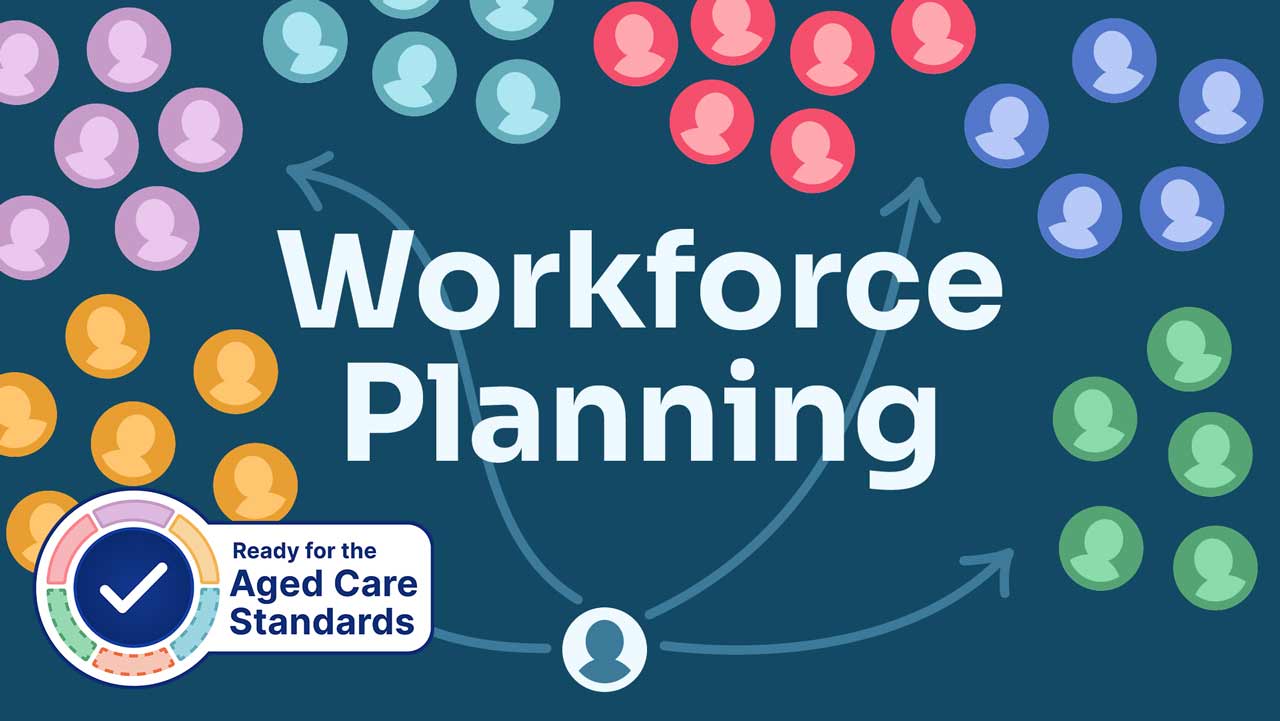What is Workforce Planning?
Appropriate workforce planning is crucial in providing safe, high-quality care. Aged care organisations are expected to have enough staff members with an appropriate range of skills to meet the needs of all older people in their care (ACQSC 2022).
There are four crucial elements of workforce planning:
- Recruitment: Hiring staff members based on required qualifications and skills
- Development: Providing training and upskilling for staff to fulfill current and anticipated needs
- Management: Optimising the performance and capabilities of the current workforce
- Retention: Keeping engagement and satisfaction levels high to preserve to sustain staff.
(ACQSC 2023a)

Workforce Composition
An aged care organisation’s workforce should comprise a variety of occupations, employment types (e.g. full-time, contract) and qualifications (ACQSC 2023a).
For example, there are a variety of people that an aged care provider needs to employ in order to provide comprehensive care and function as an organisation, including registered nurses, enrolled nurses, personal care workers and non-clinical staff (e.g. cleaners, maintenance staff, laundry staff and kitchen staff, including chefs).
Furthermore, it’s important that the organisation rosters the right combinations of staff at the right times in order to provide adequate care and accomplish required tasks.
Establishing a diverse workforce can lead to improved quality of care for older people and increased job satisfaction for staff. However, it’s important to note that there is no universal framework for determining the best workforce composition - this depends on each individual organisation and the needs of the older people being cared for (Koopmans et al. 2018).
What are the Current Requirements?
In response to the recommendations made by the Royal Commission Final Report in 2021, the federal government introduced minimum care minutes for residential aged care in 2023. These include:
- 200 care minutes per resident per day, including 40 minutes of direct care from a registered nurse (Note: From 1 October 2024, this is expected to increase to 215 care minutes per day including 44 minutes of direct care from an RN)
- The requirement for an RN to be on-site and on duty 24/7.
(DoHaAC 2024; Bryan 2022)
Workforce Planning Under the Strengthened Aged Care Quality Standards
Standard 2: The Organisation - Outcome 2.8: Workforce planning of the strengthened Aged Care Quality Standards requires aged care providers to:
- Implement a workforce strategy that:
- Determines, documents and monitors the number and composition of staff requird to ensure high-quality care and service delivery
- Meets minimum care requirements and collaborates with staff on planning and rostering to meet these requirements
- Recognises the required skills, qualifications and competencies for each role
- Employs staff who are appropriately qualified and competent
- Directly employs staff wherever possible to limit the use of independent contractors
- Reduces the effects and risks associated with workforce shortages and absences or unfilled positions
- Implement strategies to ensure the workforce is psychologically safe.
(ACQSC 2024)
Why is Workforce Planning Important?
As aged care models have transitioned from institutional systems to more person-centred principles over recent years, current staffing levels and workforce composition in aged care facilities have been found inadequate in achieving quality outcomes for older people (Eagar et al. 2019).
It comes down to one main principle: in order to provide high-quality, person-centred care for each older person, aged care organisations need the right number of staff with the right skills (Peters & Marnie 2021).
The Care Experience

When planning a workforce, it’s important not to forget how older people experience the care they are receiving.
Employing the bare minimum of staff, for example, may be enough to get essential tasks done but will leave older people feeling like their care is being rushed or cut short (ACQSC 2023b).
It’s not enough to only meet older people’s needs - their preferences need to be taken into consideration as well. For example, an organisation should have enough staff for older people to request a staff member of a specific gender or choose what time they prefer to have a shower (ACQSC 2023b).
Another important aspect of the resident experience is the concept of continuity of care - repeated contact between a care recipient and a specific staff member (Wright 2018), which allows rapport, trust and a positive relationship to be established.
Older people should be able to receive continuity of care and know the staff members who will be caring for them, as this will improve their care experience (ACQSC 2023b).
Conclusion
Workforce planning is more than just ‘hiring enough people’.
In order to provide high-quality, safe care, aged care organisations must not only hire the right number of people but also ensure they are the right mix of people.
By ensuring the workforce can support both the needs and preferences of older people and by rostering staff so that the right combination of people are performing the right tasks at the right time, older people will receive the right amount of care and attention.
Test Your Knowledge
Question 1 of 3
What is a key requirement for aged care providers in implementing a workforce strategy?
Topics
References
- Aged Care Quality and Safety Commission 2024, Standard 2: The Organisation, Australian Government, viewed 22 April 2024, https://www.health.gov.au/resources/publications/strengthened-aged-care-quality-standards-august-2025?language=en
- Aged Care Quality and Safety Commission 2023b, Guidance and Resources for Providers to Support the Aged Care Quality Standards, Australian Government, viewed 22 April 2024, https://www.agedcarequality.gov.au/resource-library/guidance-and-resources-providers-support-aged-care-quality-standards
- Aged Care Quality and Safety Commission 2022, Workforce Governance and Management – Fact Sheet for Providers, Australian Government, viewed 19 April 2024, https://www.agedcarequality.gov.au/resource-library/workforce-governance-and-management-fact-sheet-providers
- Aged Care Quality and Safety Commission 2023a, Workforce Planning & Management, Australian Government, viewed 19 April 2024, https://www.agedcarequality.gov.au/media/97297
- Bryan, M 2022, ‘Mandatory Care Minutes and 24/7 RNs in Aged Care: What You Need to Know’, Aged Care Essentials, 9 August, viewed 22 April 2024, https://www.agedcareessentials.com.au/news/mandatory-care-minutes-and-24/7-rns-in-aged-care-what-you-need-to-know
- Department of Health and Aged Care 2024, Care Minutes in Residential Aged Care, Australian Government, viewed 22 April 2024, https://www.health.gov.au/our-work/care-minutes-registered-nurses-aged-care/care-minutes
- Eagar, K et al. 2019, How Australian Residential Aged Care Staffing Levels Compare With International and National Benchmarks: A Research Study Commissioned by the Royal Commission into Aged Care Quality and Safety, Centre for Health Service Development, Australian Health Services Research Institute, University of Wollongong, viewed 19 April 2024, https://agedcare.royalcommission.gov.au/system/files/2020-06/AHS.0001.0001.0001.pdf
- Koopmans, L, Damen, N & Wagner, C 2018, ‘Does Diverse Staff and Skill Mix of Teams Impact Quality of Care in Long-Term Elderly Health Care? An Exploratory Case Study’, BMC Health Services Research, vol. 18, viewed 19 April 2024, https://bmchealthservres.biomedcentral.com/articles/10.1186/s12913-018-3812-4
- Peters, MDJ & Marnie, C 2021, ‘Mandated Minimum Staffing Levels and Skills Mix Key to Delivering Quality Aged Care, New Paper Argues’, Australian Nursing & Midwifery Journal, 22 April, viewed 22 April 2024, https://anmj.org.au/mandated-minimum-staffing-levels-and-skills-mix-key-to-delivering-quality-aged-care-new-paper-argues/
- Wright, M 2018, ‘Continuity of Care’, Australian Journal of General Practice, viewed 22 April 2024, https://www1.racgp.org.au/ajgp/2018/october/continuity-of-care-is-in-the-eye-of-the-beholder

